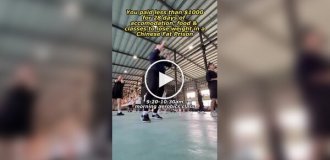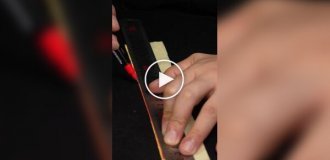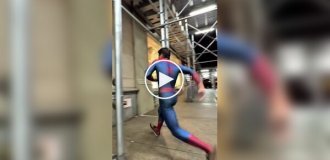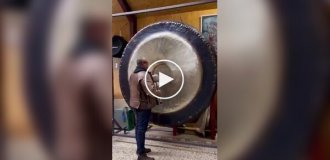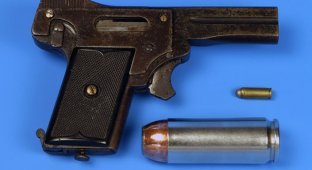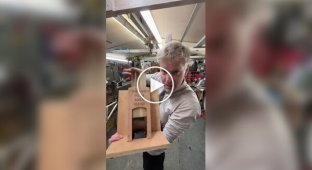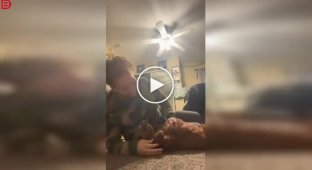Colt's idea of creating a revolver was prompted by observations of a rotating mechanism on the ship "Corvo", on which he traveled from Boston to Calcutta. On board the Corvo, he made a model out of wood; upon returning to the United States, Colt applied to the patent office and issued patent No. 1304 dated August 29 (according to other sources, February 25), 1836, describing the basic principle of operation of a weapon with a rotating drum.

Colt Paterson
In late 1836, Colt's Patent Firearms Manufacturing Company in Paterson, New Jersey began production of Colt's five-shot .28-caliber cap revolvers, sold under the name Colt Paterson. In total, until 1842, 1,450 revolving rifles and carbines, 462 revolving shotguns and 2,350 revolvers were produced. Naturally, all weapons were percussion caps. The first samples were characterized by low reliability, regular breakdowns and a very imperfect design, not to mention the extremely unsafe and inconvenient reloading process. Not surprisingly, the US government showed little interest in the new weapon. The Army purchased only a few revolver carbines for testing. The largest customer for Colt's company was the Republic of Texas, which bought 180 revolving shotguns and rifles for the Rangers, and about the same number of revolvers for the Texas Navy. A number of revolvers (more powerful caliber - .36) were ordered privately by the Texas Rangers themselves with their own money. Low demand in 1842 led to the bankruptcy of the factory.
Colt Paterson made 1836-1838 (still without loading rod)

Thus, the most popular Colt Paterson revolver model produced in Paterson was the No. 5 Holster, also known as the Texas Paterson, a .36 caliber revolver. About 1,000 units were produced. Half of them occurred in the period from 1842 to 1847, after bankruptcy. Their production was established by Colt's creditor and former partner John Ehlers.
Colt Paterson 1836-1838 with the trigger retracted

One of the most significant conflicts involving the use of Colt Paterson revolvers was the Battle of Bander Pass between the Mexican Army and Texas Rangers, among whom was US Army Captain Samuel Walker. Later, during the Mexican-American War, Walker met Colt and together with him modified the Colt Paterson revolver, called the Colt Walker. There was good demand for it, since the Colt Walker was much more reliable and convenient than its predecessor. Thanks to this, Colt returned to developing weapons in 1847.
Texas Rangers.

From a technical point of view, the Colt Paterson is a five-shot open-frame revolver. Single action trigger mechanism (English Single Action, SA) with a trigger folding inside the body. Each time you fire, you have to cock the hammer. The revolver is loaded from the muzzle of the chambers - with gunpowder and a bullet (round or conical) or with a ready-made cartridge in a paper sleeve containing a bullet and gunpowder.
.44 caliber paper cartridges and loading tool

Capsules (still produced today - for lovers of such weapons)

Then a primer is placed on the brand tube in the breech of the drum - a miniature cup made of soft metal (usually brass) with a small charge of shock-sensitive fulminate of mercury. On impact, the charge explodes and creates a jet of flame, which, through a fire tube, ignites the powder charge in the chamber. Everything that has been said about the principles of operation of such weapons applies to all other capsule revolvers.
Sights consist of a front sight and a rear sight on the trigger. Loading early models of Colt Paterson revolvers, produced before 1839, was carried out only by partially disassembling it and removing the drum, using a special tool - essentially a small press for pressing bullets into the chambers of the drum.
This process was long and inconvenient, especially in the field. Not only was reloading the Colt Paterson unsafe, but carrying it was also unsafe, as there were no manual safeties. To speed up reloading, gunfighters usually carried several pre-loaded drums with them and simply changed them as needed. In later models, from 1839, the design featured a built-in pressing lever-ramrod and a special hole in the front of the frame for it. This mechanism made it possible to significantly speed up and simplify reloading - now it was possible to equip the drum without removing it from the revolver. This improvement made it possible to get rid of the additional tool, and from that time on the ramrod lever became an integral element of the design of almost all Colt capsule revolvers.
Colt Paterson made 1842-1847 with a shortened barrel and a ramrod lever for loading

Some performance characteristics of Colt Paterson in .36 caliber with a barrel length of 7.5 inches (it should be borne in mind that even for the same model of percussion weapon they may differ slightly):
— initial bullet speed, m/s — 270;
— sighting range, m — 60;
— weight, kg — 1.2;
— length, mm — 350.
So, the first Colt Paterson revolvers were actively used by the Rangers and the Navy of the Republic of Texas, and were used very limitedly by the US Army. Colt Paterson was used in clashes between the Republic of Texas and Mexico, in the Mexican-American War, and in the US war with the Seminole and Comanche tribes.
Such revolvers are very highly valued today. Colt Paterson in original box with all accessories sold at auction in 2011 for $977,500

Colt Walker
The Colt Walker was developed in 1846 by Samuel Colt and Texas Ranger Captain Samuel Hamilton Walker. According to the widespread version, Walker suggested that Colt develop a powerful .44 caliber army revolver instead of the relatively weak and not very reliable .36 caliber Colt Paterson revolvers then in service. In 1847, Colt's newly formed Colt's Manufacturing Company in Hartford, Connecticut (where it remains to this day) produced the first batch of 1,100 Colt Walker revolvers, which also became the last. That same year, Samuel Walker was killed in Texas during the Mexican-American War.
The Colt Walker is a six-shot, open-frame, capsule-operated revolver with an added trigger guard. The Colt Walker is Colt's largest black powder revolver, weighing 2.5 kilograms. From this moment on, all “non-pocket” models of Colt capsule revolvers became six-shooters.
Some performance characteristics of Colt Walker .44 caliber:
— initial bullet speed, m/s — 300-370;
— sighting range, m — 90-100;
— weight, kg — 2.5;
— length, mm — 394.
The Colt Walker was used by both sides in the North-South War.
Colt Walker

Colt Dragoon Model 1848
The Colt Model 1848 Precision Army revolver was designed by Samuel Colt in 1848 at the request of the US government to arm the U.S. Army's Mounted Rifles, better known in the US as dragoons. Hence its name, under which the revolver went down in history - Colt Dragoon Model 1848. In this model, a number of shortcomings of the previous Colt Walker model were eliminated - the Colt Dragoon had less weight and a ramrod lock was added.
Colt Dragoon Model 1848



There were three releases of the Colt Dragoon model, differing from each other by minor improvements in the firing mechanism:
- first issue: from 1848 to 1850, about 7,000 were issued;
- second issue: from 1850 to 1851, about 2,550 were issued;
- third edition: from 1851 to 1860, about 10,000 Colt Dragoon revolvers were produced, of which the US government purchased more than 8,000 units.
Thus, the Colt Dragoon was produced for 12 years. The Colt company produced about 20,000 of these revolvers. The Colt Dragoon turned out to be a very successful revolver.
Holster and belt for Colt Dragoon Model 1848

Separately, it is worth noting the production since 1848 of its pocket version, the Colt Pocket Model 1848 in .31 caliber, better known as the Baby Dragoon, especially popular with civilians.
Some performance characteristics of the Colt Dragoon Model 1848 caliber .44, with a barrel length of 8 inches:
— initial bullet speed, m/s — 330;
— sighting range, m — 70-75;
— weight, kg — 1.9;
— length, mm — 375.
The Colt Dragoon Model 1848 was used by the US and Confederate armies in the War of the North and South. A significant portion was sold to civilians.
Colt Pocket Model 1848 Baby Dragoon

Colt Navy 1851
The Colt Revolving Belt Pistol of Naval Caliber (.36 caliber), better known as the Colt Navy 1851, was developed by Colt specifically to equip US Navy officers. Colt Navy turned out to be such a successful model that its production continued until 1873 (from 1861 - Colt Navy Model 1861), when armies around the world switched en masse to a unitary cartridge. The Colt Navy was in production for a record 18 years in various models, with approximately 250,000 of them produced in the United States. A further 22,000 units were manufactured in the UK at the London Armory factory. The Colt Navy is considered one of the most advanced and beautiful capsule revolvers in history.
Colt Navy 1851


The trigger mechanism has been improved: a special pin is made in the breech of the drum between the chambers, thanks to which, if the drum is not turned enough, accidental firing of the trigger does not cause ignition of the capsules. The Colt Navy has an octagonal barrel.
Colt Navy 1851 revolvers were in service not only with the US Army, where their main competitor was the Remington M1858 revolver, but also with army officers of the Russian Empire (which ordered a large batch from Colt), Austria-Hungary, Prussia and other countries.
Some performance characteristics of Colt Navy 1851 caliber .36:
— initial bullet speed, m/s — 230;
— sighting range, m — 70-75;
— weight, kg — 1.2-1.3;
— length, mm — 330.
Colt Navy was actively used by both sides in the war between the North and South. It became the first capsule revolver to be massively converted to a unitary cartridge.
Winchester .44 Rimfire black powder rimfire cartridges

The differences from the capsule Colt Navy are clearly visible: a new drum with a door in the rear for loading, the ramrod lever has been removed and instead a spring-loaded extractor has been installed to remove spent cartridges, the depth of the recess at the rear of the drum has been increased for ease of loading with cartridges.
Colt Navy Model 1861 conversion



Remington M1858
The Remington M1858 cap revolver, also known as the Remington New Model, was developed by the American company Eliphalet Remington & Sons and was produced in .36 and .44 calibers. Due to the fact that Colt was the patent holder, Remington was forced to pay him a royalty on each revolver produced, so the price of Remington revolvers was significantly higher than similar Colt revolvers. The Remington M1858 revolver was produced until 1875.
Remington M1858

Over 17 years, approximately 132,000 Remington M1858 revolvers were produced in .44 caliber (military model with an 8-inch barrel) and .36 caliber (naval model with a 7.375-inch barrel). There were three large releases in total, which were almost identical - minor differences were in the appearance of the trigger, the design of the under-barrel lever and the drum.
From a technical point of view, the Remington M1858 is a six-shot cap revolver with a solid frame, the loading of which is carried out by placing ready-made cartridges in a paper case or black powder bullets into the chambers of the drum on the muzzle side, after which the primers were placed in the breech of the drum.
Single action trigger mechanism (English: Single Action, SA), no manual safeties.
Some performance characteristics of the Remington M1858 in .44 caliber, with an 8-inch barrel:
— initial bullet speed, m/s — about 350;
— sighting range, m — 70-75;
— weight, kg — 1.270;
— length, mm — 337.
Remington M1858 revolvers were in service with the army of the United States, the British and Russian empires, Japan, Mexico, and others.
A Northern Army cavalry soldier with three Remington M1858s

The Remington M1858 was actively redesigned for a unitary cartridge. Since 1868, the company itself began producing a conversion version of the Remington M1858 revolver chambered for the .46 rimfire black powder cartridge.
Remington M1858 conversion


Colt Army Model 1860
The Colt Army Model 1860 revolver was developed in 1860 and became one of the most common revolvers during the American Civil War. Produced for 13 years. In total, about 200,000 Colt Army Model 1860 revolvers were produced before 1873, and about 130,000 of them were made for the US government.
It had a modification with longitudinal grooves on the cylinder and less weight - the Texas Model, so named because most of these revolvers were purchased by Texas Rangers after the Civil War.
The Colt Army Model 1860 revolver, along with the Colt Navy 1851 and Remington M1858, became one of the most beloved revolvers of its era. It was actively purchased not only by the military, but also by civilians. Moreover, revolvers were relatively inexpensive back then. For example, a Colt Army Model 1860 cost $20 (for comparison, the price of an ounce of gold on the New York Exchange in 1862 was $20.67).
Colt Army Model 1860


Some performance characteristics of the Colt Army Model 1860 in .44 caliber:
— initial bullet speed, m/s — 270-305;
— sighting range, m — 70-90;
— weight, kg — 1.2-1.3;
— length, mm — 355.
Colt Army Model 1860 revolvers were used by the US Army and the Confederates, and after the Civil War by the Texas Rangers. They took part in the US wars with the Indians: the Colorado War, the Dakota War, etc. It was massively redesigned for a unitary cartridge.
On the left is a Colt Army Model 1860 capsule, on the right is a conversion with the door open.

Colt Army Model 1860 conversion

Peacemaker
1873 was a banner year for Colt. She began production of the most famous revolver in history - the Colt M1873 Single Action Army, better known as the Peacemaker. Along with the Smith & Wesson .44 Magnum revolver, the Peacemaker has become a cult weapon that today has entire communities of fans. Suffice it to say that the production of first-generation Peacemakers for the civilian weapons market continued until... 1940!
Colt М1873 Single Action Army "Peacemaker"

The Peacemaker was initially produced in the powerful .45 Long Colt black powder caliber with a 7.5" barrel, with 5.5" and 4.75" barrel models soon available. Later, revolvers of .44-40 WCF and .32-20 WCF (Winchester) calibers appeared, and in the 20th century they were supplemented by variants chambered for .22 LR, .38 Special, .357 Magnum, .44 Special, etc. - just more than 30 calibers!
The Peacemaker for the US Army was produced for 9 years - until 1892, when the Peacemakers were withdrawn from service (the artillery model continued to be used until 1902) and replaced by the Colt Double Action M1892. And in total, until 1940, 357,859 first-generation Peacemakers were produced, of which 37,000 revolvers were purchased for the American army.
The Peacemaker is a six-shot solid frame revolver that is loaded through a hinged door in the cylinder on the right side of the revolver. There is a spring-loaded extractor for removing spent cartridges, located below and to the right of the barrel. The design provides for setting the trigger to the safety half-cock.
Peacemaker, a variant of the Buntline Special, with a barrel length of 16 inches (almost 41 cm)!



Some first-generation Peacemaker performance characteristics chambered for the .45 Long Colt black powder rimfire cartridge with a 7.5-inch barrel:
— initial bullet speed, m/s — more than 300;
— sighting range, m — n/a;
— weight, kg — 1.048;
— length, mm — 318;
- bullet energy, J - 710-750.
The Colt Peacemaker took part in the Spanish-American and Philippine-American Wars, the Great Sioux War, and the US wars against the Cheyenne and other Indian tribes.
It should also be said that the Colt Peacemaker... is actually still in production today! In 1956, Colt resumed production of the second generation Peacemaker revolvers, which continued until 1974. During this time, 73,205 of these revolvers were produced.
In the early 1970s. The US Congress passed a law prohibiting the sale of firearms without special safeties - none of the single-action revolvers of the 19th century met this requirement. Colt made the necessary changes to the design and in 1976 resumed production of the third generation Peacemakers, which continued until 1982. A total of 20,000 pieces were produced during this period. In 1994, production of Peacemakers was resumed again under the name Colt Single Action Army (Colt Cowboy), which continues to this day.
Colt Single Action Army. Modern chrome version with hunting knife included.

